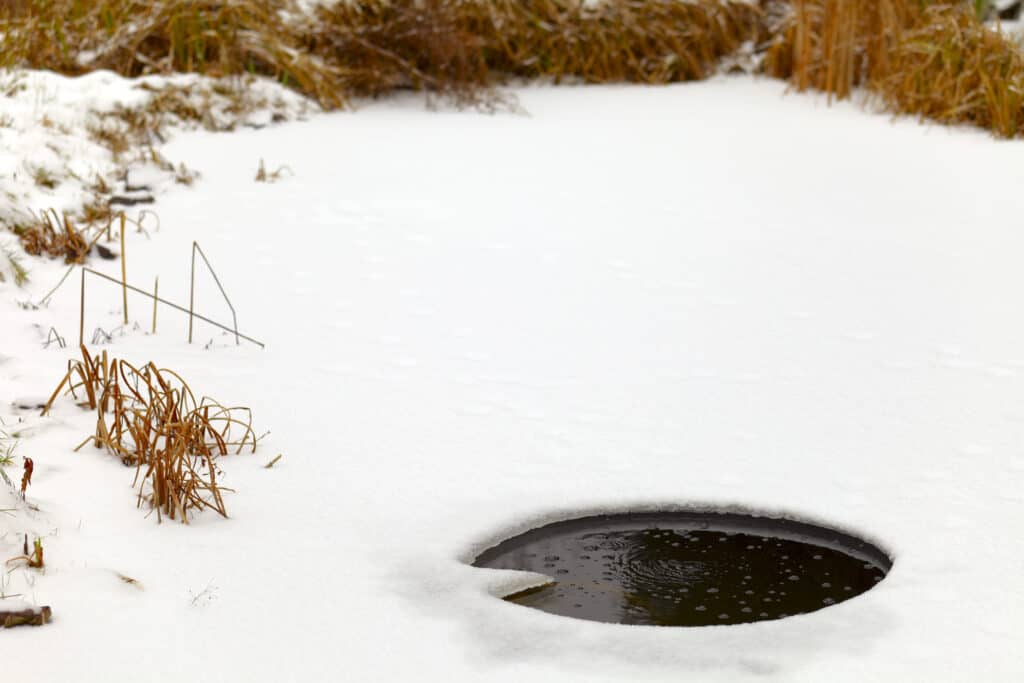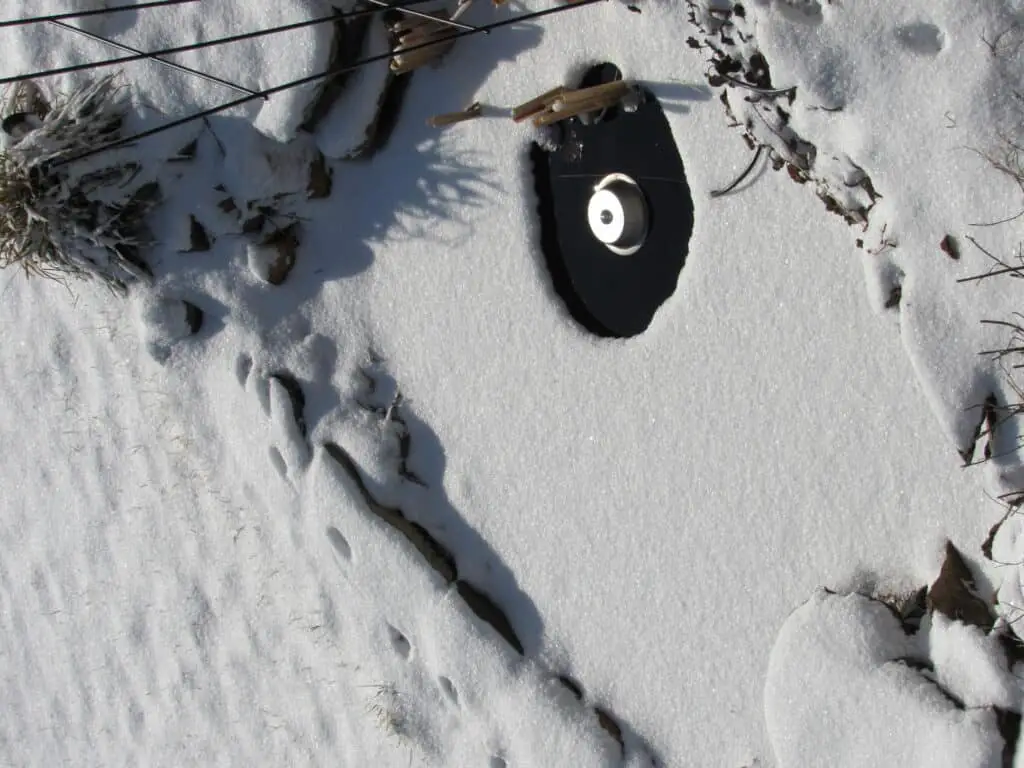
Koi fish are beautiful additions to a pond, and having a koi pond in your garden close to your house offers a sense of tranquility to your home environment. Whether you are upgrading your koi pond or installing a new pond, if you plan to keep your koi outdoors during the winter, there are a few factors that you will need to consider. The main one is how deep your koi pond should be to sustain a viable environment for your overwintering koi.
Koi ponds must be at least 3–4 feet deep to be viable environments for your koi fish during winter. If you are in an area where the surface soils freeze, ensure that your koi pond is at least 1 foot deeper than the typical topsoil or ground freeze level. Koi need 1-1.5 feet of unfrozen water.
There is a minimum limit to how shallow your koi pond can be, and this limit should be adhered to for several reasons. Many factors influence how deep your koi pond needs to be for its viability during the winter. These include the size of your koi pond, where you live, and the size of your koi fish.
Pro Tip: If you’re tired of wasting money and making costly mistakes on the koi-keeping hobby or are thinking about buying koi fish but don’t know where to start, I strongly suggest you check out this ebook. I recently read this ebook, and it contains SO much useful information, such as:
- 3 proven steps to identify koi fish diseases
- WARNING: 3 things you should NEVER do when it comes to caring for koi
- When to seek professional help when it comes to looking after your koi
The Minimum Depth For A Koi Pond In The Winter
If you plan to overwinter your koi fish in their outdoor ponds, you must ensure that your pond is a minimum of 3 feet deep, preferably 4 feet. Anything less than 3 feet can be detrimental to the health of your koi, and they might not survive the winter.
Suppose where you live experiences mild winters. In that case, the minimum 3-foot depth provides the perfect depth for your fish to remain in the lower, warmer waters and be deep enough in the water to be protected from most predators while they are in their semi-hybernating states.
Koi Pond Depth For Medium To Harsh Winters
If the area you live-in experiences medium to harsh winters where you can expect your pond water to freeze over, the 3 – 4 feet depth provides your fish with enough space below the frozen surface to survive. In most areas that experience these winters, you can expect your pond ice to get around 5 – 6 inches thick.
Therefore, the 3 – 4 feet depth allows enough room underneath for your koi to have movement when they need it. It also leaves enough water underneath for the bottom water to stay warm enough for your fish’s survival.
Koi Pond Depth For Harsh Winters
If the area you live in gets so cold that the surface soil freezes, then the ice on the surface of your koi pond could get up to 18 – 24 inches thick. In this case, your pond will need to be at least 4 feet deep to allow your fish enough room underneath to survive and stay warm.
It would help if you tried for a deep enough pond to keep the water at least 1 – 1.5 feet deeper than the surface freeze. An average of 4 – 5 feet in depth would be best for these winters. Going down to a depth of 5 feet gives your fish extra space and leaves enough unfrozen water for the correct amount of gas exchange to occur in the water.
Winter Koi Pond Depth According To Koi Size
If you have large koi fish in your pond, you might consider going for more depth to accommodate them in the winter months. Koi ponds, in general, have a depth versus size ratio. Most people who keep koi of the larger size will undoubtedly have larger and deeper ponds.
Ponds around 6 -8 feet in diameter will need a depth of around 2 – 4 feet and often vary, with some sections being 2 feet, others 3, and others 4. At the same time, 8 – 12 feet in diameter ponds will usually be 4 -6 feet in depth.
Other Factors To Consider For Your Koi Pond In Winter

The depth of your koi pond is just one of several factors you need to consider when overwintering your koi in their ponds. Two primary concerns are water aeration and ventilation.
Koi Pond Water Aeration During Winter
Even in the winter, you will need to ensure aeration in your koi pond. Aeration of a pond’s water is vital to the overall health of your fish as it stirs the water and promotes gas exchange. There are many methods to ensure that your pond water remains aerated. One of the easiest ways is if you have a waterfall as a pond feature. This way, there is permanent movement in the water. Another method is to install an artificial aeration machine in the pond, and it will provide a similar job as a waterfall.
One thing to remember here is that balance is vital. During winter, your koi fish are in a state of semi-dormancy. They are using less oxygen and will naturally settle on the bottom of their ponds. The aerator you use should only gently stir the water. You want to prevent any turbulence which will disturb your koi. Go for a gentle bubble instead of an all-out current or rolling boil.
Koi Pond Water Ventilation During Winter
It is also imperative that you not allow your koi ponds water to freeze over. If this occurs, your koi will not be able to reach the surface to breathe. If there is sufficient aeration of the water, your koi will be able to get oxygen, but the resulting bubbles from the aeration process will need a place to escape.
If you have a waterfall flowing into your pond, it should prevent it from freezing over. If you do not have a waterfall, you will need to keep an eye on the spread of the freeze. The best practice would be to select an area as a ventilation hole and keep your eye on it. If you notice that it has begun to freeze over, remove the thin ice covering the hole before it becomes too thick or hard.
You want to refrain from hitting the ice with force as this can cause shock waves in the water that can be detrimental to your fish. One method to melt the ice if it has become too thick to remove by hand is to sit a recently boiled kettle on the ice. The heat from the kettle will melt a hole, leaving enough room for ventilation.
Conclusion
The perfect koi pond depth for winter depends on the size of your fish and the area where you live. If you plan to overwinter your koi in their pond, you should aim for at least 3 – 4 feet in depth. Anything lower than 3 feet can be detrimental to the health of your fish.
References
https://www.gardenguides.com/13425269-how-to-build-a-tilapia-pond-in-a-backyard.html
https://www.quora.com/How-deep-should-a-koi-pond-be-for-winter
https://todayshomeowner.com/how-to-keep-koi-fish-in-a-pond-during-freezing-weather/
https://animals.mom.com/how-deep-should-a-fish-pond-be-12224486.html
https://animals.mom.com/can-koi-live-pond-its-frozen-top-11492.html

